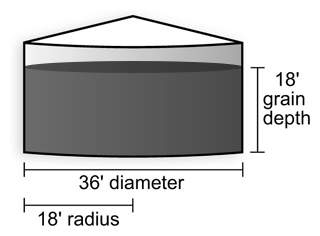How to Estimate Bushels of Grain in a Bin
Larger Grain Bins May Need Added Fan Power
October 21, 2011
Many farmers are building larger grain bins than were common 30 years ago. A typical on-farm grain bin traditionally was 27 to 36 feet in diameter and would store grain to a depth of 18 to 22 feet. Many new grain bins are 42 to 48 feet in diameter and store grain to a depth of 28 to 32 feet — almost three times the volume of the earlier bins.
Steps to Preparing Bins and Equipment for Harvest
July 21, 2011
Grain harvested in Nebraska is essentially insect-free, but can become infested by storage insects, which originate in or around the bin or in contaminated equipment such as combines and grain augers. Take time now to clean and prepare bins for this year's grain by following these tips:
Spring Grain Drying Recommendations for Large Bins
March 11, 2011
Managing large grain bins — those with diameters of 36-48 ft and heights of 28-32 ft — may require adding drying capacity and increasing monitoring efforts with warmer spring conditions.
Managing Grain Drying in High Moisture Conditions
Sept. 23, 2010
Q: Should I turn off my aeration fan when it is raining or when humidity is very high?
A: The answer depends on two considerations:
Harvest Corn Now and Store Well to Avoid Losses from Stalk Rot
Sept. 10, 2010
Still waiting for soybeans to mature? Consider harvesting corn with stalk rot now to get a jump on harvest and reduce field losses.
Ensure Quality Grain Storage by Starting with Clean Equipment, Bins
August 27, 2010
Despite the spring rains which delayed planting, it appears corn and soybeans are on track for a normal harvest date this year. Grain producers should be preparing bins and equipment now to avoid problems at harvest.
